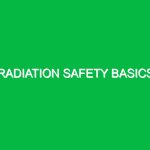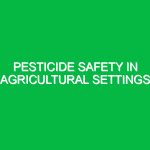Introduction
Biological hazard awareness is a crucial aspect of the Health, Safety, and Environment (HSE) domain. It involves recognizing and understanding the potential risks posed by biological agents that can affect human health and the environment. Biological hazards encompass a wide range of organisms, including bacteria, viruses, fungi, and parasites, along with their by-products. These hazards can originate from various sources, such as healthcare settings, laboratories, agricultural activities, and natural environments.
The relevance of biological hazard awareness in HSE cannot be overstated. As our world becomes more interconnected, the risk of exposure to biological agents increases. From pandemics to localized outbreaks, the consequences of ignoring biological hazards can be severe. This article delves into the various types of biological hazards, associated risks, safety precautions, and the regulations that govern biological hazard awareness.
Understanding Biological Hazards
Biological hazards can be categorized into several types, each posing unique risks. Here, we’ll explore some of the most prevalent biological hazards.
1. Infectious Agents
Infectious agents, such as bacteria and viruses, are perhaps the most recognized biological hazards. They can be transmitted through direct contact, airborne particles, or contaminated surfaces. For instance, the outbreak of COVID-19 highlighted how quickly a virus can spread globally, emphasizing the importance of biological hazard awareness.
Other examples include antibiotic-resistant bacteria, commonly found in healthcare settings. These pathogens can lead to serious infections that are difficult to treat, making awareness and preventive measures critical.
2. Allergens
Allergens like mold spores, pollen, or animal dander can trigger allergic reactions in susceptible individuals. In workplaces, particularly those involving agricultural or laboratory settings, exposure to biological allergens can lead to significant health issues. For example, workers in grain handling facilities may face exposure to mold, necessitating proper ventilation and personal protective equipment (PPE).
3. Zoonotic Diseases
Zoonotic diseases are transmitted from animals to humans and often pose significant health threats. The World Health Organization (WHO) reports that more than 60% of infectious diseases in humans are zoonotic. An illustrative case is the transmission of the H1N1 virus from swine to humans, which caused widespread concern and prompted global health initiatives.
4. Environmental Pathogens
Environmental pathogens, such as those found in water or soil, can lead to serious health problems. For instance, the bacteria Legionella, which thrives in warm water, can cause Legionnaires’ disease, a severe form of pneumonia. Awareness of such pathogens is crucial for public health, especially in maintaining safe water supplies.
Identifying Risks Associated with Biological Hazards
Understanding the potential risks associated with biological hazards is essential for effective prevention and response strategies. Here are some key risks linked to biological hazards.
1. Occupational Exposure
Workers in various industries, such as healthcare, agriculture, and waste management, are at higher risk of exposure to biological hazards. For example, healthcare workers dealing with infectious patients are particularly vulnerable to bloodborne pathogens. This necessitates stringent protocols for handling potentially infectious materials.
2. Environmental Contamination
Biological hazards can contaminate the environment, affecting not only human health but also wildlife and ecosystems. For instance, agricultural runoff containing pathogens can lead to water pollution, impacting drinking water sources and recreational areas. Awareness of these risks is vital for sustainable environmental practices.
3. Public Health Threats
Biological hazards pose significant threats to public health. Outbreaks of diseases can strain healthcare systems and lead to widespread panic. The Ebola outbreak in West Africa is a stark reminder of how biological hazards can escalate into public health emergencies, necessitating a coordinated response from governments and organizations.
Safety Precautions and Best Practices
Implementing effective safety precautions is key to mitigating risks associated with biological hazards. Here are some best practices to consider:
1. Personal Protective Equipment (PPE)
Wearing appropriate PPE is essential when handling biological hazards. This includes gloves, masks, goggles, and gowns, depending on the nature of the hazard. For instance, laboratory personnel working with infectious agents should always wear gloves and masks to prevent exposure.
2. Hygiene Practices
Promoting good hygiene practices helps reduce the risk of exposure to biological hazards. Regular handwashing, use of hand sanitizers, and proper disposal of waste materials are fundamental practices. In healthcare settings, adherence to infection control protocols, such as sterilization and disinfection, is critical.
3. Training and Awareness
Regular training sessions for employees about biological hazards and safety protocols can significantly lessen risks. For example, a hospital might conduct mandatory training for staff on how to handle potentially infectious materials safely. This not only equips employees with knowledge but also fosters a culture of safety.
4. Safe Work Practices
Developing and enforcing safe work practices is vital. This includes establishing clear protocols for handling biological materials, reporting incidents, and conducting risk assessments. In a laboratory setting, for example, protocols might involve using biosafety cabinets when working with pathogens.
Regulations and Standards Governing Biological Hazard Awareness
Several regulations and standards govern biological hazard awareness to ensure the safety of workers and the public. Understanding these regulations is essential for compliance and effective risk management.
1. Occupational Safety and Health Administration (OSHA)
In the United States, OSHA provides guidelines for protecting workers from biological hazards. The Bloodborne Pathogens Standard (29 CFR 1910.1030) mandates that employers implement measures to protect employees from exposure to blood and other potentially infectious materials.
2. Centers for Disease Control and Prevention (CDC)
The CDC offers extensive resources and guidelines related to biological hazards, particularly infectious diseases. Their recommendations for infection control and prevention in healthcare settings are widely regarded as the standard of care.
3. World Health Organization (WHO)
At the international level, the WHO plays a vital role in addressing biological hazards. Their guidelines on handling outbreaks and managing biological risks are essential for global health security. During the COVID-19 pandemic, the WHO’s recommendations helped shape national responses worldwide.
Conclusion
Biological hazard awareness is an indispensable component of the Health, Safety, and Environment (HSE) domain. By understanding the types of biological hazards, recognizing associated risks, and implementing safety precautions, we can create safer work environments and protect public health.
As we have seen through various examples, the implications of neglecting biological hazards can be dire, affecting not only individuals but entire communities. Therefore, fostering a culture of awareness and preparedness is essential in mitigating these risks. By adhering to guidelines and regulations set forth by organizations such as OSHA, CDC, and WHO, we can collectively work towards a safer future in the face of biological threats. In an era where the interconnections between health, environment, and safety are more pronounced than ever, the importance of biological hazard awareness cannot be overstated.


